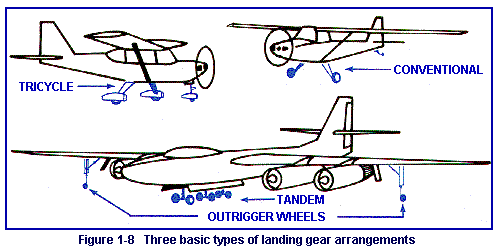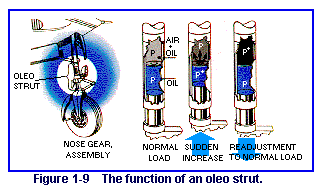 |
|||||
| Home | Research | For Teachers | HISTORY Level 1 Level 2 Level 3 |
PRINCIPLES Level 1 Level 2 Level 3 |
CAREER Level 1 Level 2 Level 3 |
| Gallery | Hot Links | What's New! | |||
| Web Administration and Tools | |||||
 |
|||||
| Home | Research | For Teachers | HISTORY Level 1 Level 2 Level 3 |
PRINCIPLES Level 1 Level 2 Level 3 |
CAREER Level 1 Level 2 Level 3 |
| Gallery | Hot Links | What's New! | |||
| Web Administration and Tools | |||||
![]()
Airplanes require landing gear for taxiing, takeoff, and landing. The earliest airplane of all--the Wright Flyer--used skids as its landing gear. Soon, wheels were attached to the skids. Since that time, various arrangements have been used for wheels and structures to connect them to the airplane. Today, there are three common types of landing gear: conventional, tricycle, and tandem (see figure 1-8).

Conventional landing gear consists of two wheels forward of the aircraft's center of gravity and a third small wheel at the tail. This type of landing gear is most often seen in older general aviation airplanes. The two main wheels are fastened to the fuselage by struts. Without a wheel at the nose of the plane, it easily pitches over if brakes are applied too soon. Because the tailwheel is castered--free to move in any direction--the plane is very difficult to control when landing or taking off.
 The tricycle landing gear, as you can guess from its name, has
three wheels--two main wheels and a nosewheel (see figure 1-9). This type of landing gear
makes the aircraft easier to handle on the ground and it also makes landings much safer.
An aircraft equipped with tricycle landing gear is less apt to pitch forward.
The tricycle landing gear, as you can guess from its name, has
three wheels--two main wheels and a nosewheel (see figure 1-9). This type of landing gear
makes the aircraft easier to handle on the ground and it also makes landings much safer.
An aircraft equipped with tricycle landing gear is less apt to pitch forward.
The tandem landing gear is used for very large aircraft like the B-52 bomber and the U-2 reconnaissance/research aircraft. The main landing gear is in two sets that are located one behind the other on the fuselage. The tandem landing gear allows the use of a highly flexible wing, but it may also require the use of small wheels on the tips of the wings to keep the wings from scraping the ground.
Send all comments to ![]() aeromaster@eng.fiu.edu
aeromaster@eng.fiu.edu
© 1995-98 ALLSTAR Network. All rights reserved worldwide.
| Funded in part by | From Civil Air Patrol Educational Materials |
Updated: February 17, 1999